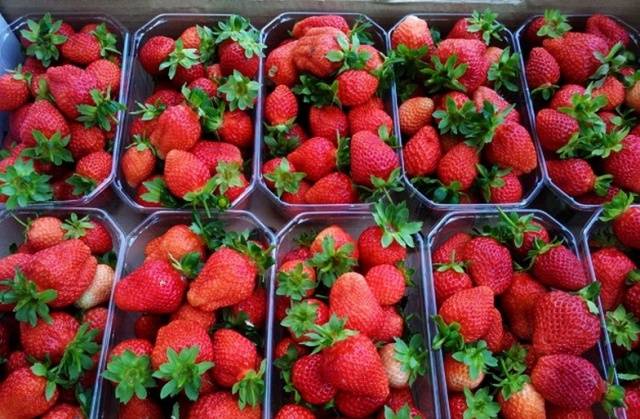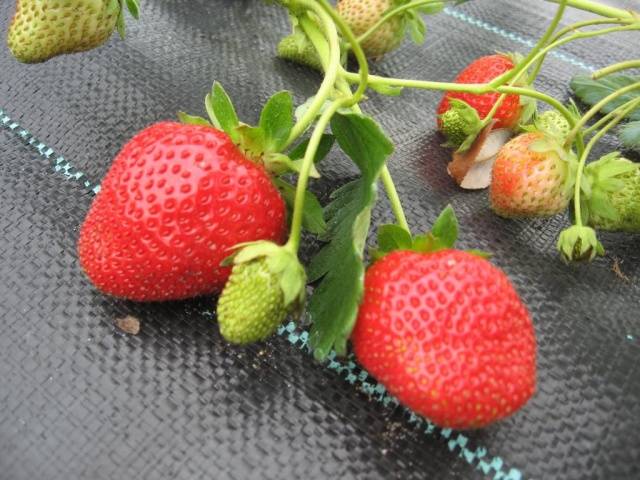Content
Today there are a lot of large-fruited dessert varieties of strawberries - gardeners really have plenty to choose from. However, taking a closer look, you can see that the vast majority of these varieties have early or medium ripening periods. But I would like to enjoy the aromatic berries longer! One of the latest varieties of garden strawberries is the Italian hybrid Galya Chiv. This strawberry caused a lot of noise and caused thousands of disputes; gardeners from all over the country will not come to a common opinion: is this variety good or does it have no right to exist. The inconsistency of Gali Chiv lies in approximately the same number of advantages and disadvantages of this variety.
To figure out whether the Galya Chiv variety is worthy of the attention of domestic gardeners, below will be a full description of strawberries with photos and reviews from summer residents. All the pros and cons of this garden strawberry will be listed here, as well as an alternative way to grow the sweet berry will be proposed.
Characteristics from the copyright holder
Large producers have one opinion about the Galya Chiv strawberry, small farms think about it completely differently, and owners of homestead farms and dachas evaluate the variety using completely different criteria.To better understand the situation, you must first hear the copyright holder - what he says about his own brainchild.
The late variety has the original name Galia CIV, its originator is the Italian consortium of nurseries C.I.V. Strawberries are positioned as a medium-late or late ripening crop, suitable for cultivation in continental climates (including Eastern Europe and central Russia).
Description of the strawberry variety Galya Chiv, the Italian consortium offers the following:
- a crop with late ripening and extended fruiting (the first berries will ripen in early July, the harvest can be harvested throughout the month);
- bushes are vigorous, powerful, spreading;
- peduncles are thick and long, multi-berry - up to 20 ovaries on one peduncle;
- the peduncles are located at the same level with the leaves (which can be called a plus);
- Gali Chiv's flowers are large, they contain a lot of pollen - there are no problems with pollination of strawberries;
- the whisker formation is average - the whiskers are quite sufficient for the propagation of strawberries, but there are not so many of them that this becomes a problem;
- there are few leaves on the bushes - about 7-8 pieces;
- the berries are large, colored red-orange, and have a glossy surface;
- the average weight of Gali Chiv fruits can vary from 20 to 70 grams (depending on the age of the strawberries, weather conditions, soil composition);
- the shape of the berries resembles a truncated cone with a rounded tip, there is no neck;
- it cannot be said that strawberries are homogeneous - both their shape and size can differ greatly (which garden strawberry sellers will definitely not like);
- the fruits of the first harvest are the heaviest, they may have a slightly flattened shape and a ribbed surface;
- the adhesion of the berry to the sepal is strong, so the strawberry cannot be pulled off dryly;
- the pulp is whitish, dense, very juicy;
- taste rating by tasters is 4.6 points;
- Galya Chiv strawberries are very sweet and have a pleasant strawberry aroma;
- the amount of precipitation has virtually no effect on the sugar content of berries;
- The root system of the garden crop is well developed, the roots are powerful and long, going deep underground;
- The winter hardiness of the Galya Chiv variety is good - strawberries can withstand frosts down to -30 degrees without shelter;
- deep roots allow the variety to cope well with drought;
- disease resistance, according to Italian breeders, is average;
- domestic farmers note that Galya rarely suffers from powdery mildew and gray mold, and has average immunity to fungal spots;
- the yield of Italian strawberries strongly depends on the age of the bushes and their growing conditions, therefore it ranges from 300 to 800 grams per bush;
- on an industrial scale, farmers manage to harvest about 5 tons of berries per hectare of fields in the first year after planting, about 24 tons in the second year of fruiting and 15 tons in the third season (these figures clearly demonstrate the decrease in the yield of older bushes);
- The variety is capable of fully bearing fruit only for two or three seasons, after which the berries become smaller and their number decreases;
- The fruits cannot withstand transportation and storage, since the strawberries are quite soft and come off the peduncle poorly (the harvested crop quickly “drains”).
Purpose of the variety: table: Gali Chiv berries are most suitable for fresh consumption.
Which is more: pros or cons?
It’s not for nothing that reviews of the Galya Chiv variety of strawberries are so contradictory: this crop is very ambiguous. Farmers who are thinking about buying seedlings of this strawberry can be advised to do one thing: immediately decide for what purpose this variety will be grown. As the practice and experience of gardeners shows, Italian strawberries perform best on private farms and small farm plots.
Italian strawberries have advantages, and they are hard to miss. These are qualities such as:
- good yield;
- large size and attractive appearance of the berries;
- pleasant taste of fruits;
- normal resistance to diseases;
- frost resistance sufficient for the Russian climate;
- the ability of strawberries to tolerate short-term drought;
- strong and rapid bush growth, easy propagation.
Unfortunately, The Italian strawberry Galya Chiv also has many shortcomings. Here is their list:
- tight tearing leading to damage to the berry;
- short lifespan - already in the third year of fruiting the berry becomes very small;
- the need to normalize the ovaries (too many fruits will lead to a reduction in the size of the strawberries and the appearance of unripe berries);
- severe depletion of soil by a powerful and fast-growing plant;
- fear of damp climate - during periods of prolonged rains, Galya Chiv often suffers from fungal infections;
- poor survival rate of seedlings during the hot period - a large number of attacks are possible;
- unsuitability for long-distance transportation;
- very different sizes and shapes of fruits depending on the time of collection and age of the bush.
Many farmers complain about the too simple, bland and not multifaceted taste of Gali Chiv. However, supporters of this variety refute such information and prove that The taste qualities of Italian strawberries strongly depend on the nutritional value of the soil, climatic features and the efforts of the gardener put into the strawberries.
If you start to find fault, you can find a couple more shortcomings. For example, Russian sellers of fresh fruits do not really like the Galya Chiv variety because the color of the berries is too light and their pulp is whitish. Domestic buyers prefer varieties with darker color and rich red flesh. Although in Europe, on the contrary, light strawberries are valued more. So, we can argue endlessly.
Alternative growing method
The strawberry variety Galya Chiv is universal - it can be grown using any method (from conventional planting to growing in greenhouses and greenhouses). In central Russia, the most effective way to grow strawberries is to plant bushes in high beds. This method will be discussed in more detail.
There are many advantages of high beds, but the main ones are considered to be a lower risk of infection and pest damage to strawberries, as well as cleaner and drier fruits that do not come into contact with the ground. No less advantageous is the fact that in high beds there is no need to loosen the soil; they practically do not grow there. weeds and moisture never stagnates.
The optimal time for planting the Galya Chiv variety is autumn, then the crop will have more time to acclimatize, and strawberries will bear fruit next year. If, nevertheless, you had to plant Galya in the spring, you should do it as early as possible - the bushes are severely damaged by the sun and can completely disappear.
The soil for raised beds is prepared in advance. A few weeks before planting the Galya Chiv variety, loose soil should be mixed with fertilizers: humus, compost, mineral complexes, wood ash.
It’s not difficult to build raised beds for strawberries:
- The selected area must be marked and dug up, while removing weeds and roots.
- Form a ridge about 15 cm high from the soil
- Plant young strawberries on the top of the ridge, keeping an interval of 20-25 cm between the bushes.
- The remaining ridges are poured parallel to the first, the distance between them should be about 30 cm.
- The holes for the Galya Chiv variety should be large and deep, since this strawberry has long and powerful roots.
- When planting a seedling, its roots must be straightened, preventing them from bending upward.
- High beds with strawberries must be mulched.The soil around the Galya Chiv strawberry bushes can be covered with straw or sawdust, but the best option is to plant the plants on an agrospand.
- Planted strawberries need to be watered thoroughly. You can add fertilizers (for example, superphosphate) to the water for irrigation.
Rules of care
It is not difficult to care for Galya Chiv - this strawberry is unpretentious and will not cause much trouble for the gardener. But Growing a late large-fruited variety has its own characteristics:
- After planting, the bushes are watered almost every day, constantly monitoring the degree of soil moisture.
- It is best to water mature strawberries by sprinkling or using a drip irrigation system for watering.
- If you mulch the soil with straw and lay agrospand on top, garden strawberries will never get fungal infections.
- Every 2-3 weeks it is recommended to feed strawberries with mineral complexes or organic matter dissolved in water (bird droppings, cow manure).
- Carry out preventive treatment of Gali Chiv against pests and infections, spraying the bushes with special preparations several times a season.
- Trim off excess ovaries and inflorescences to prevent overloading of bushes and regulate the size of the berries.
- Dig up garden strawberry tendrils to propagate the variety. Or trim the tendrils if propagation is not required, as they draw a lot of energy from the plant.
- In the fall, clear the bushes of dry leaves, diseased shoots and other debris.
Review
Conclusion
Italian strawberry Galya Chiv has generally proven itself well among the country's gardeners. This variety cannot be called industrial, but it is perfect for growing on private farms and in summer cottages. The farmer must be prepared for the fact that the beds with Galya will have to be regularly fertilized, and the harvested crop will have to be quickly sold. You shouldn’t expect any other “surprises” from the variety - it is time-tested and tested many times in the Russian climate.




















